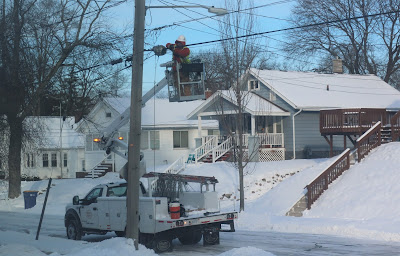 |
| Swapping copper wires for fiber-optic lines 4 Feb. 2022 ZIP 49505 |
Despite the cold temperature the workers steadily string the surprisingly narrow gauge spools of fiber-optic cable along the path of existing copper lines. Rolling the clock back 10 years to 2012, smartphones were increasingly appearing in pockets and handbags around the country and wider world. The earlier transition from 2G (2nd generation) to 3G had been completed and the first rumors of 4G were described here and there. Currently on sale in stores and websites are the widespread availability of 5G handsets, despite fragmented operation of the towers and transmitters/receivers inside and outside of the USA. The past week or two the risk of 5G wavelengths interfering with airport flight operations has been in the news since one federal agency sells the use of certain frequencies of the radio spectrum (FCC) and another is concerned with safe flight operations (FAA). Little or no coordination between these parts of the government seems to have taken place. The sale of the 5G frequencies took place at the end of President Trump's term of office and only now when the wireless system near major airports is ready to start to fill the airwaves is the FAA raising concern with conflict to cockpit equipment that reports altitude above ground surface.
The photo shows residential service improvements to the pace of Internet data flowing in and out of household wifi hotspots. The existing provision via copper lines has more friction or restrictions on the amount of information flowing to and fro. As a result the experience of using the Internet during the prime time entertainment hours (from 7 to 10 p.m.) after residents return from work sometimes is frustrating when streaming video or audio is less than free-flowing.
On the biggest junctions and sites of Internet use at corporate, university, and government centers there has been an exclusive "Internet2" that is dedicated to the biggest bandwidth requirements of virtual reality, 3-D engagement, and real-time performing surgery at a distance. But for residential customers paying monthly for service at differing tiers (datarate and caps on cumulative bits of data up or downloaded), the advent of fiber-optic broadband in place of copper-based cables may well give a taste of the extreme speeds of the Internet2.
Much like museum visitors staring at an early vacuum tube radio mutely on display, or seeing an early retail TV with its screen blank, people who visit a future museum and see a PC or section of copper cable or one made with fiber-optic stands will understand only the surface of the artifacts, not the programming that entertained, informed, challenged, or created worldviews of (social media) citizens immersed for large parts of their waking hours in the bright and dark corners of the Internet. As for teaching future museum-goers about the Dark Web, that is even a bigger stretch of the imagination.
At first look, this photos seems to show a straight-forward job of upgrading the on-ramp to the Information Superhighway, as Vice-President Al Gore phrased the Internet for a generation unequipped to imagine such a thing, But acknowledging that "the medium IS the message," as Marshall McLuhan described the effects of endless advertising and consumer appeals, the increase in Internet speed, capacity, and reliability is much, much more than swapping copper cable and connectors for the fiber-optic kind. By many orders of magnitude, this in-reach to householders and out-reach from residential and business locations makes the world much smaller and immediate. What once seemed far away now is just a few clicks or bookmarked websites away. Time zones still exist, but with prerecorded content, it is possible to engage with someone or something asynchronously, rather than "live" only. As a result, events of a fixed date and time, and taking place far from the online participants can form extended dialogues not limited to synchronous, "real time" experiences. And once archived or hosted online in recorded, transcript form, people also far into the future can revisit the conversation or presentation, too. And so, this photo of the warmly dressed workers putting all the pieces together for an even freer flow of data is bound to lead to unexpected good and bad things, unintended (and perhaps unknowable) consequences that maybe will only be seen in hindsight.